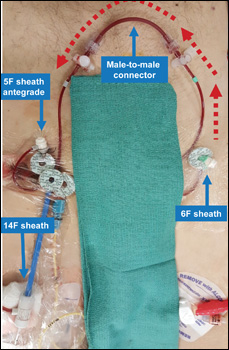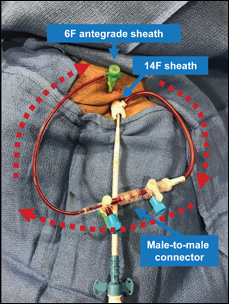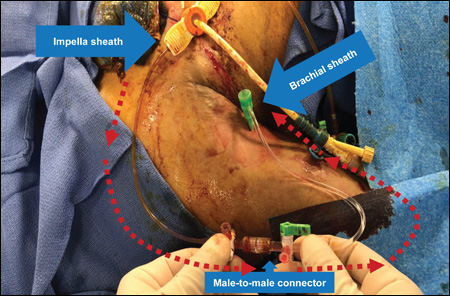The Challenge of Large Bore Occlusive Sheath Management: Strategies for Success
Despite recent increased adaptation of smaller catheters and radial access for coronary interventions, new transcatheter procedures such as transcatheter aortic valve replacement, endovascular aneurysm repair and mechanical circulatory support devices, which are all increasing in volume, require large bore access.

As CAD and peripheral artery disease are components of the same disease spectrum, it is not uncommon to encounter significant iliofemoral arterial disease compromising the distal perfusion beyond the access point. This is especially challenging in practice among patients who are hemodynamically dependent on a short-term mechanical support device and their large bore sheath is found to be occlusive. However, several interventions can be performed in the setting of an occlusive sheath to restore perfusion to the distal lower extremity in such patients. This column describes several strategies for success.
External Contralateral Bypass Circuit

If there is occlusion of the external iliac artery and common femoral artery by the large bore sheath, the ipsilateral superficial femoral artery is accessed via a 4F or 5F short sheath with a micropuncture kit in antegrade fashion. Contralateral common femoral artery access is then obtained with a 6F sheath. Then, the side arm of the contralateral sheath is connected to the side arm of the ipsilateral antegrade sheath using a male-to-male connector. The result is an external femoral-femoral bypass, whereby blood flows from the contralateral 6F sheath through the side arm into the side arm of the ipsilateral 5F antegrade sheath down the ischemic limb providing adequate perfusion (Figure 1).
External Ipsilateral Bypass Circuit
An alternative strategy utilizes the sidearm of the large bore occlusive sheath to create an ipsilateral bypass circuit. A 4F to 5F short sheath is inserted in the ipsilateral superficial femoral artery with a micropuncture kit in antegrade fashion. The side arm of the ipsilateral antegrade sheath can then be connected via a male-to-male connector to the side arm of the large bore occlusive sheath constituting an ipsilateral bypass circuit that provides adequate perfusion to the lower limb. When using this strategy with an Impella device (Abiomed), the repositioning sheath must not be advanced into the Impella sheath to avoid occlusion of the side arm that is now providing perfusion (Figure 2).

Internal Contralateral Bypass Circuit
In other settings, the superficial femoral artery may be diseased and totally occluded — not an uncommon finding in patients with CAD — which may preclude antegrade superficial femoral artery access. In such cases, internal contralateral femoral to profunda bypass might be an alternative option to maintain perfusion to the ischemic limb.

This is achieved by first inserting a 7F sheath in the contralateral common femoral artery. Through this sheath, a 5F catheter (IMA; Omni Flush, AngioDynamics) is advanced and selectively engaged into the ipsilateral common iliac artery. A 0.035-in hydrophilic guidewire (Terumo Glidewire) is then advanced through this system across the aorto-iliac bifurcation, past the occlusive large bore sheath and beyond the arteriotomy site into the ipsilateral profunda femoris artery in case of SFA occlusion. The 5F catheter is then exchanged for a 4F, 45-cm to 55-cm sheath that is advanced over the wire into the ipsilateral profunda femoris. By connecting the side arm of the 7F contralateral sheath and that of the 4F, 45-cm to 55-cm sheath using a male-to-male connector, a bypass circuit is created, whereby blood flows from the contralateral femoral artery via the connected side arms, through the crossover 4F sheath into the ipsilateral profunda femoris artery distal to the occlusive sheath providing sufficient perfusion to maintain limb viability (Figure 3).
Axillary Alternative Access Occlusive Sheath

Although typically smaller than the common femoral artery, the axillary artery has been shown to be an acceptable alternative access site for mechanical circulatory support in the presence of severe PAD. In rare cases, perfusion of the distal arm can be compromised, especially when the axillary artery is less than 5.5 mm. In these cases, an internal or external bypass conduit should be performed to restore perfusion to the ipsilateral hand.
External Axillary-Radial Bypass

There may be cases when occlusion of the axillary artery is anticipated due to a small axillary artery. In these cases, we recommend preemptive ipsilateral radial artery access. To do so, a 6F sheath is inserted in the ipsilateral radial artery. Using long extension tubing and via a male-to-male connector, the side arm of the large bore is connected to the side arm of the radial sheath. Using this technique, a bypass circuit is created, whereby blood flows from the ipsilateral axillary artery into the ipsilateral radial artery, providing sufficient perfusion to the arm and hand (Figure 4).
External Axillary-Brachial Bypass
Antegrade access of the ipsilateral brachial artery is done using ultrasound or angiographic guidance. If there is not enough flow distal to the occlusive sheath, advancing a 0.038-in wire beyond the large bore access point into the brachial artery can be used as guide to the brachial artery for needle stick. Under direct fluoroscopy, the vessel is accessed with a micropuncture needle exchanged for 6F sheath. Then the side arms of the large bore and the brachial sheath are connected using a male-to-male connector (Figure 5).


Internal Femoral-Axillary Bypass
Via 6F femoral artery sheath and using a JR4 guiding catheter, a 0.038-in guidewire (Terumo Glidewire) is advanced into the ipsilateral brachial artery. The JR4 guide catheter is then removed and exchanged for a 4F guiding catheter that is advanced over the guidewire into the ipsilateral brachial artery. The wire is then removed and the 4F guide catheter side arm is connected with the 6F side arm using a male-to-male connector (Figure 6).

Summary
As the scope of interventional cardiology is widening, it is prudent for the interventionalist to become familiar with obtaining and managing large bore accesses. Strategies for the management of occlusive sheaths are imperative to provide prolonged hemodynamic support and maintain large bore sheath access, without jeopardizing perfusion to the extremity.
- For more information:
- Amir Kaki, MD, is medical director of Cardiac Catherization Laboratories and CHIP fellowship program director at Detroit Medical Center. M. Chadi Alraies, MD, is an interventional cardiology fellow at Wayne State University, Detroit Heart Hospital. Theodore Schreiber, MD, is academic chair, Division of Cardiovascular Diseases, Wayne State School of Medicine. The authors can be reached at alraies@hotmail.com.
Disclosures: The authors report no relevant financial disclosures.
